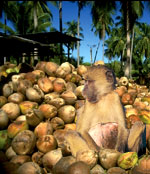Gary Hughes is a graduate student in the University of Montana Environmental Studies Program, who is traveling and researching conservation issues in Chilean and Argentine Patagonia. The things he misses most about Montana are skiing in the trees and working with the Missoula grassroots solidarity organization Community Action for Justice in the Americas.
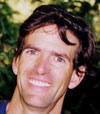
Monday, 26 Nov 2001
PARQUE PUMALIN, Chile
A good pair of rubber boots is an important asset when walking wet, muddy trails through a dense evergreen forest. They are less desirable, however, when hiking a rough gravel road in the warm afternoon sun. Sweaty feet aside, botas de goma are a necessary part of your wardrobe in many parts of the Chilean and Argentine Patagonian forests.
A month ago, Lucas Chiappe of the Argentine environmental organization Proyecto Lemu was happy to see me with rubber boots. Lucas is an avid naturalist and photographer, and he has lived with his family in Argentine Patagonia for more than 25 years. I was helping him clean an irrigation ditch on his family’s organic farm; persistent rains had clogged the ditch with debris, causing it to overflow in the wrong places. “It’s so good that you brought your rubber boots with you,” exclaimed Lucas, as he cleared brush with a machete while I shoveled and raked material out of the swollen canal.
I was visiting Lucas as part of an extended trip in Chile and Argentina to gather information for my graduate projects in the Environmental Studies Program at the University of Montana. My hope is that my research on conservation strategies, ecology, and environmental law will support groups like Proyecto Lemu and the Chilean environmental organization Defensores del Bosque Chileno in gaining new international protections for the temperate forests of the southern cone. The proposed protection area is known as the Gondwana Forests Sanctuary and focuses mostly on Chile, Argentina, New Zealand, and Australia, though there is interest in broadening the project to include all southern hemisphere forests containing species that can be traced back to the ancient Gondwana continent.
This far-reaching and idealistic proposal to increase protection for the unique temperate ancient forest ecosystems of the southern hemisphere forms the basis for an integrated conservation campaign by an international network of environmental NGOs. Because of the varied goals of the campaign — from protecting wild areas to promoting sustainable forestry — the use of the word “sanctuary” can be confusing. Often the proposal is simply referred to as the Gondwana Project as a way of emphasizing the common and ancient characteristics shared by the temperate southern hemisphere regions.
Though the campaign takes many forms, the vision of the Gondwana Forests Sanctuary for the Patagonian region is based on principles of conservation biology and bioregional economics. The reserve system design that I am researching is based on the importance of the in situ protection of biological diversity by implementing regional planning. The work of Lucas Chiappe and Proyecto Lemu is indicative of this strategy. One of Lucas’ main projects has been to promote a corridor of protected areas for the long strip of north Patagonian forest that extends along the eastern flanks of the Andes on the Chile-Argentina border. The corridor will build on the already established national parks in the Argentine provinces of Neuquen, Rio Negro, and Chubut by creating new provincial parks that will connect the national parks.
Lucas says he really started campaigning for the corridor after participating in the 1994 international temperate forest conference organized by the Native Forest Network in Missoula, Mt. He helped make an award-winning documentary video in 1996 about the proposed corridor, which has contributed to awareness of and enthusiasm for the project. In the past year, many groups involved with the Argentine National Parks system have started promoting the eco-regional corridor, including long-time Argentine native forest advocate Daniel Paz. In August, the natural resource and foreign relations committees of the Argentine National Congress passed resolutions declaring the Gondwana Project to be of national interest, and the eco-regional corridor the best means of demonstrating Argentina’s commitment to the international protected area proposal.
This afternoon, Lucas and Proyecto Lemu seem a world away, although they are really less than 100 miles to the east. Because of the international nature of my project, I have returned to Chile. I am walking along the Camino Austral, north of Chaiten, through Parque Pumalin. Parque Pumalin is possibly the most significant private conservation initiative in all of the Americas; I have had the pleasure to spend several amazing and wondrous days here. Tonight I will stay at Cascadas Escondidas, a former military encampment now transformed into a comfortable campground in the midst of Chile’s Valdivian rainforest, and tomorrow I will travel south along the Camino Austral, further into Patagonia.
One of the key roles for North Americans involved with the Gondwana Project is to draw international attention to threats posed by mega-development projects to the ancient forests in the southern cone. Even after spending a full day lost in the splendor of the rainforest, it is impossible to forget that many dangers lie on the horizon. I have appointments in Coihaique, in Aysen province, to learn more about Alumysa, a $2.7 billion hydroelectric and aluminum smelter project proposed by the Canadian mining company NORANDA. I would enjoy staying in Pumalin longer, but duty calls, and I must travel south.
Tuesday, 27 Nov 2001
PARQUE PUMALIN, Chile
It was five years ago that I visited Parque Pumalin for the first time, while working as a guide out of Pucon, Chile, for Hosteria ¡ecole!. This morning the golden light of a clear morning reflects off the verdant green of the Valdivian rainforest, and Pumalin amazes me as much now as it did five years ago.
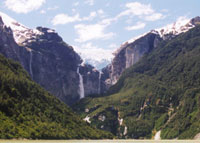
Hanging glacier over Laguna Tempanos.
Photo: Gary Hughes.
I have to give thanks to Rick Klein of Ancient Forests International for encouraging me to learn about Chile, and for all of his hard work. Over the last fifteen years “alerce” Rick has done as much as anyone to bring international conservation attention to the native forests of Chile. I also tip my hat to the courageous people who are working to make the Pumalin project a success in the face of sometimes-frightening opposition. When one considers the importance of the International Forum on Globalization and the Foundation for Deep Ecology, it could be said that the efforts of Kris and Doug Tompkins help reduce the loss felt by the passing of David Brower.
With my bags packed, I walk out to the gravel road that is the Camino Austral (the Southern Highway), the main terrestrial transportation artery in southern Chile. The southern highway is basically a penetration road, and it was only quick action by Chilean and North American cons
ervation interests that kept the landscape around this section of the highway practically pristine. Much of the rest of the Camino Austral has provided access for extensive clearing and burning of the evergreen forest. In Pumalin though, the highway winds through dense rainforest and true wild country.
Another major road project a little further north in Chile threatens to eliminate the oldest of all the remaining Valdivian rainforest. When Chilean President Ricardo Lagos was public works minister in the previous administration, he initiated the Southern Coastal Highway to connect the city of Valdivia with the city of Puerto Montt by way of the Pacific Coast. This route passes along the western flanks of the Cordillera de la Costa, the coastal range, which contains the oldest and most diverse rain forest remaining in southern South America. Much of the coastal range was never disturbed by the great glaciations that covered the Patagonian Andes, including precious places like Pumalin. Although endemism throughout the sub-Antarctic region of South America runs high, the genetic diversity in the coastal range can be traced back without interruption for several millions of years. Many species can be traced back 160 million years to the ancient Gondwana continent.
It is estimated that 90 percent of the flowering plants in the Patagonian forest exist nowhere else on earth. The coast range of Chile’s Lakes Region contains the last large intact reserves of forest that served as refugium during the glaciations and volcanic disturbances that have occurred with geological regularity over the last hundreds of thousands of years. Yet despite the global ecological significance of the coastal forest, the Chilean government is moving ahead with an infrastructure plan that will further fragment these ancient rainforests and, worse still, facilitate their conversion to monoculture plantations of exotic eucalypt and pine species.
As I sit by the side of the road, waiting for the van that passes only three times a week between Caleta Gonzalo and Chaiten, I reflect on the work of Francisco Solis and the Coastal Range Coalition (Coalicion para la Conservacion de la Cordillera de la Costa). Francisco has been working to develop a broad coalition of Chilean and international environmental, sustainable forestry, indigenous, and scientific groups to support conservation initiatives in the coastal range. Their immediate goal is to halt the construction of the coastal highway and promote a more ecologically and socially sensitive route for transportation infrastructure along the eastern flanks of the coastal range. It was Francisco who inspired the Rainforest Action Network, the Natural Resources Defense Council, and the Forest Conservation Web Portal to organize letter writing and email campaigns to encourage President Lagos to halt construction of the Southern Coastal Highway.
One of the greatest threats that the road presents to the coastal Valdivian rainforest is that such infrastructure will attract new investor interest in the presently dormant Cascada-Chile wood chipping project. This mega-project, originally proposed by Boise Cascade Corporation, would be the largest wood chipping and oriented strand board facility in the Americas. Even without transnational wood projects, the coastal road is leading to the degradation of the forest. As the Engineering Corps of the Chilean Army has extended the road, a Chilean company called Bosques S.A. has burnt the rainforest to plant exotic eucalyptus for future wood chipping. If the Southern Coastal Highway continues as planned, it will certainly doom the last rainforest of its type on the planet. With courageous organizing by people like Francisco though, there is still a great possibility of halting the road’s advance.
Wednesday, 28 Nov 2001
QUEULAT NATIONAL PARK, Chile
After a good hike to a viewpoint overlooking a granite amphitheatre at a hanging glacier, I have slipped away along another trail to lose myself in the bosque siempreverde of Patagonia. Clouds are gathering, but it is not yet raining. Mosses and ferns cover the trunks of 100-foot broadleaf trees. I notice the seemingly ever-present Coigue (Nothofagus dombeyi), one of the most common trees in the Southern Andes forest. The nothofagus species are among those that can be traced back to the ancient Gondwana continent, and are present in nearly all the temperate forests in the southern cone. The nothofagus are one of the symbols of the Gondwana Forests Sanctuary campaign, the international grassroots effort to increase environmental protection and bioregional economic planning in the southern hemisphere nations of Chile, Argentina, New Zealand, and Australia.
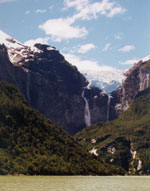
Hanging glacier in Parque Nacional Queulat.
Photo: Gary Hughes.
Today I am exploring the most accessible sector of Chile’s Queulat National Park. Although more than 40 percent of the park is comprised of glacial ice in the high country of the Andes, it is also host to several deep and hidden valleys covered in southern evergreen forest. The thick understory of ferns and bamboo-like quila (Chusqea quila) is overshadowed by large Tepa (Laurelia phillipiana) and Luma (Amomyrtus luma) trees. In openings where the sun breaks through the canopy, flowering bushes of Aromo (Azara lanceolata) and Chilco (Fuchsia magellanica) add brilliant colors to the shades of green and silver dominating the forest spectrum. I have taken a break from my southerly travels along the Camino Austral to examine the fringes of this 370,000-acre national park in southern Chile.
Some 18 percent of Chile is included in the national system of protected areas. These parks and reserves are all managed by CONAF, the national forestry agency, which is actually a semi-private corporation that exists in a difficult-to-describe institutional limbo. There is no separate administrative body for the management of Chilean parks. Many segments of the Chilean and international business community contend that 18 percent of the country is enough protected land, and that no more parks or reserves should be established. However, RENACE, the National Network for Ecological Action, has studied foreign investment in the Chilean forestry sector and the national parks system. Their findings reveal that a large percentage of the protected area (including Queulat) is desert, rock, and ice, and that many other forest types, such as the coastal rainforest, are seriously underrepresented.
I finish my day of hiking thinking about the many unidentified moss, lichen, fern, and insect species hidden in remote corners of the unique Valdivian forest that may not be included in a protected area. Just as I return to camp, the rain starts. Ivan, one of the two park rangers, drops by to invite me to watch television later that night. I accept; they have a small hydro-powered generator for their cabin, and I want to see the news. As much as I treasure losing myself in the mountains and the woods, I have awakened every morning thinking about the violence of war. Being in Latin America during such confusing times provides a profound learning experience.
This isn’t the first time I’ve had that experience. I was living and working in Nicaragua while the Persian Gulf War raged in 1991, and I have been in Chile and Argentina since May 2001. The news one receives outside the U.S. is very different from the news one receives within the U.S., especially during these violent
crisis. In Argentina the newspapers publish many photos of Afghan victims of the violence, and Chilean television is not shy about showing graphic images of wounded civilians. Yet it is not just news from Central Asia that sheds light on history and current events concerning the U.S. Recently it was revealed that Henry Kissinger and the Central Intelligence Agency financed and organized the Chilean extreme right wing group that assassinated Rene Schneider. Schneider was the chief of the Chilean military and was assassinated the day after democratically elected Salvador Allende was inaugurated in 1970. General Augusto Pinochet took control of the Chilean armed forces, and three years later, on Sept. 11, 1973, he took over the Chilean government in a CIA- and Kissinger-supported military coup.
The significance of the date has not been lost on the Chilean people. After the attacks in New York City and Virginia, many people asked me if I thought it was possible that elements of the U.S. intelligence services and secret police were somehow involved or had known about the attacks. I am also often asked about the presidential elections a year ago, and if I can explain what happened. I am still not sure how to respond in such conversations, as these discussions only exacerbate my most paranoid concerns about covert action, secret government, and the politics of cover-ups. After more than 15 years of working on human rights and environmental issues in north, central, and south America, I have come to understand that there are powerful and hidden interests of many political stripes that think nothing of the taking of innocent life, at home and abroad, human and otherwise.
Although these events have nothing to do with my current research projects, these histories are directly related to environmental issues. I am reminded of a talk I once heard by Ron Ericson, who is one of the founders of the University of Montana Environmental Studies Program. He said that the program was founded during the Vietnam War, when the connections between the violence of the military-industrial complex and the violence of the resource extraction industries were becoming too obvious to ignore.
Traveling and working outside the U.S. during this challenging time has sometimes been nerve-wracking, and I miss having many friends and family available. But the people of Chilean and Argentine Patagonia are amongst the most trustworthy on Earth, and the water is safe to drink from almost any mountain stream. As well, the perspective on the history, politics, and character of my nation have been unforgettable.
Thursday, 29 Nov 2001
QUEULAT NATIONAL PARK, Chile
I waited five hours in the rain today for the bus heading south to Coihaique to pass the entrance to Parque Nacional Queulat. As anyone who’s ever done it knows, the romance and adventure of foreign travel often translates to days of dirty clothes, bad weather, and long waits at remote crossroads. Happily, Ivan the park ranger was waiting for the bus as well, in order to send a letter to his family in Puerto Aysen, so I got a chance to discuss the mission and history of the park, and the environmental challenges facing the Patagonian region.
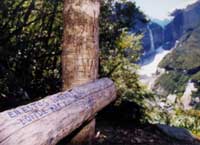
“In these places is where I feel the most free.”
Photo: Gary Hughes.
The people working for CONAF (the Chilean Forestry Agency) have been unfailingly friendly and helpful in my efforts to gather information. In Las Escalas, outside of the Futaleufu Reserve and Huemul Project, a man named Nestor invited me to have lunch in order to talk about the huemul (Hippocamelus bisulcus), the endangered Andean deer.
The Futuleufu Reserve is composed of 12,000 hectares of Andean mountain terrain just south of the Futeleufu River, a famous whitewater destination. Over cazuela, a typical stew with chicken, Nestor told me that there are probably only six to 10 huemules surviving in the reserve. Excessive hunting, loss of habitat, and competition from exotic grazers such as cows, sheep, goats, horses, and even European deer and hares have pushed the huemul to the extreme brink of extinction. He said that after initial difficulties, the people in Las Escalas had come to understand why the reserve exists, and that protecting the huemul was a community effort.
The loss of the huemul in Patagonia would be more than just an ecological tragedy. The cultural implications are also grave, as the huemul is a national symbol in Chile. The humeul appears with the Andean Condor on the national shield. Unless Chilean society begins to place more value on the huemul, the shield could become like the California state flag with its image of a grizzly bear — another example of natural heritage becoming myth and entire societies waxing amnesiac about what our landscapes looked like only decades or a century in the past.
During another interview, Werner Fleuck, a Swiss wildlife biologist now living in Argentina, told me that although no real census has been made, it is likely that there are fewer than 1,500 huemul individuals left on the planet. The single greatest threat to the huemul, once plentiful in the Patagonian Andes, is habitat loss.
It is this concern that Dr. Anthony Povilitis shared with me when I started learning about NORANDA’s aluminum smelter proposal for Aysen. Alumysa is a proposal to invest $2.7 billion in three separate hydroelectric plants and an aluminum plant to process minerals imported from Australia. The hydroelectric plants alone will result in the drowning of 25,000 acres of habitat for flora and fauna species. This number does not include the cumulative impact of road infrastructure, power line right-of-way, contamination from emissions, an increased demand for building materials and fire wood for employees of construction efforts, the possibilities of illegal hunting, and the potential for yet more industrial development in one of the planets last extensive pristine landscapes.
The research that I am doing on the Gondwana Project proposal includes gathering information on the huemul to assist in proposing a design for a bi-national system of protected areas that will help meet the habitat needs of the huemul. The Gondwana Forests Sanctuary proposal includes promoting the huemul as an umbrella species; that is, through protecting habitat for the huemul, sufficient habitat can be secured for other species. In addition, the huemul functions as a focal species in that it is a charismatic and treasured member of the natural community that can help attract popular support for regional conservation planning in the southern Andes. Much work has already been done along these lines by several agencies and environmental groups. The huemul is probably one of the best examples of bi-national conservation cooperation in Chile and Argentina. Nevertheless, looming mega-development projects like the one proposed by NORANDA demonstrate that endangered species like the huemul could still fall victim to poor ecological planning.
Ivan, the CONAF ranger from Queulat, says that although he has never seen huemul in the park, they are back there in the hidden recesses. There are not very many, but they are still there. I am thinking about this as the Coihaique bound bus passes the southern boundary of the park, and the bits of burned and cleared forest become the dominant patch on the mosaic of the landscape. Patagonia still has extensive wild country, but it is a region in the balance. As we bounce through the cold rain along the lonely gravel road that is the Camino Austral, I can only hope that my work will help keep our planet’s ecological accounts from falling into the negative.
Friday, 30 Nov 2001
COIHAIQUE, Chile
< p>Coihaique is the most important town in the Aysen region of southern Chile, and is home to nearly half of the region’s 100,000 inhabitants. It is the largest city between Puerto Montt and Punta Arenas, a distance of more than 900 miles. The southern end of the Americas is distinct from the northern end. Instead of the landmass getting larger as it nears the polar region, it gets smaller. Nevertheless, Patagonia has few inhabitants, and there are expanses of land still uninhabited by human beings. Almost directly in the middle is Coihaique, an administrative, education, business, and cultural center for the region.
Today, for what feels like the first time in a long time, I am wearing dry clothes and clean socks. While watching the cold rain squalls blow across the valley in which Coihaique rests, I listen intently to Peter Hartmann as he tells me stories about Aysen, its wildness, and the development of the region.
Peter is an architect who came to Aysen with an interest in working in his field — urban and regional planning. After living in Aysen, he began to get more involved with national and local environmental organizations. Peter is on the national board of directors of the Committee in Defense of the Flora and Fauna of Chile (CODEFF), and was instrumental in the campaign to declare Aysen a Reserva de la Vida, a reserve of life. Looking at mega-projects such as NORANDA’s Alumysa proposal, Peter says the challenge is to turn the slogan into practice.
“One of the most valuable aspects of the reserva de vida designation has been a ‘green seal’ for organic cattle and agriculture because of the clean air and water of the region,” Peter tells me. Bringing in an aluminum smelter may endanger this green seal. “Why manufacture aluminum for export when we could bottle water for export? If we are going to export products to the global markets they shouldn’t be from processes that damage the pristine nature of the region.”
His comments make a great deal of sense. It was Lucas Chiappe of Proyecto Lemu who put me in contact with Peter, and like Lucas, Peter is a true maestro. Peter thinks the Gondwana Forests Sanctuary is a nice idea, but in places like Aysen, protecting more wild land cannot be the only goal. Managing and actually protecting the places already designated as parks and reserves must take first priority if they are to be more than just parks on paper. The next priority, and Peter really emphasizes this, must be restoring the millions of acres of damaged and eroded land. This is where the Gondwana umbrella becomes a project about regional planning. If a sanctuary means people can’t touch a tree, that model won’t work in all of Aysen. In protected areas this is certainly important; it is how we maintain ecological viability. But there must be investment in managed and sustainable use of many productive elements of the landscape.
Peters’s comments fit with what I have been pondering: If we cannot make lands that are already in use economically productive, our protected areas will almost certainly end up isolated and worn away by attrition. Buffer zones, biological corridors, zones of sustainable management, and responsible investment are all essential aspects of regional planning.
But an aluminum smelter in Aysen, constructed by a trans-national corporation with a shady environmental and labor history? This does not seem like responsible investment. Having lived my whole life in the Pacific Northwest, I am familiar with the aluminum industry. I can’t think of aluminum without thinking about the demise of the salmon due to the damming of the Columbia River. I cannot think of aluminum without thinking of the plight of steelworkers, abandoned by an industry that is unwilling to pay the wages that such dangerous work merits, and abandoned by a government that pursues trade agreements that make it illegal to protect local ecology and economy. I think about the dead forest above Columbia Falls, Mt., and how the aluminum plant there makes money selling deregulated electricity back to the grid instead of employing people to make aluminum. Closing plants in North America and building new plants in Patagonia? Something is extremely wrong here.
Two years ago, on Nov. 30, 1999, in a cold pre-dawn rain, I had the great honor of being in the streets of Seattle with many thousands of other people from all over the world who shared my feeling that “something is extremely wrong here.” I know that being present for the mobilization in Seattle during the World Trade Organization ministerial was one of the most important things I have ever done. We demanded transparency and participation. Critics who call me a globaphobe could not be further from the truth. I am not afraid of the global village; rather, I defend it. I am, however, afraid of the same thing that we all fear, but that many are unwilling to come to grips with: that we have lost control of our governments and our economies; that the people who are in control care only about maximizing their profits, no matter what the human or natural expense.
Still, I will not let this fear freeze me like an endangered Andean deer in the headlights of extinction. There is work to be done, and life to be celebrated. Concepts like the Gondwana Project seem very dreamy when contemplating the context of current geo-politics. There is a saying, though, that to have principles is to come out of adversity with your dreams intact. The adversity is evident, but my travels have shown me that there are many people dedicated to keeping our common dreams alive.
